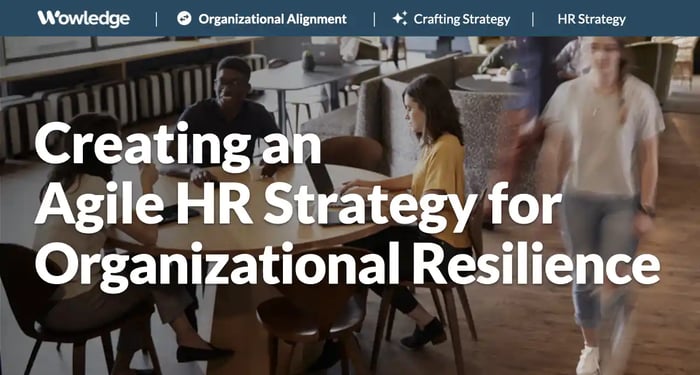Table of Contents
HR strategic planning continues to challenge many companies, as CHROs and their teams face increasing pressure to manage day-to-day talent issues at the cost of longer-term thinking and goal-setting. Challenges arise from tighter HR budgets and staffing levels, labor shortages, employee retention during economic and market uncertainties, and widespread worker stress and burnout. With the typical HR strategic planning approach requiring weeks or months of effort from leaders across HR functions and business units, many companies either delay, shortcut, or altogether forgo the process in any given year. A more agile HR strategy development process could help overcome challenges and maintain a continuously evolving approach to planning.
Aside from the difficulties arising from more recent business trends, HR strategic planning has historically (and continues to) suffer from some commonly experienced issues that limit the effectiveness and impact of those, which stem from problems such as:
- Lack of business alignment. Too often, these plans are focused on talent issues (turnover, engagement, satisfaction) and HR efficiencies (cost per hire, time to fill, training program completions, benefits selections) that are not connected to specific business goals and objectives (revenue generation, profitability, targeted and critical workforce segment performance). This issue is most concerning to business leaders, leading to the perception of HR as an administrative burden rather than a strategic business partner.
- Low ownership and commitment by senior leadership. Too often, these plans are developed independently of the leadership team, even after consulting with or interviewing them. As a result, they fail to gain buy-in from senior leadership, who approve plans and associated budgets, and do not secure the necessary sponsorship and championing that can drive acceptance and adoption among middle management.
- Unresponsive to business issues and challenges as they arise. As with strategic plans at the business or functional levels, these are frequently developed, documented, and then set aside until year-end for HR contribution and performance reporting. Sadly, this results in stagnant plans that fail to activate the HR teams to course-correct and address business issues as they arise. This leads to efforts and resources being improperly focused on tackling outdated challenges, resulting in a scramble to plug holes with minimal planning.
- Communications related to progress and results. Too often, the sharing and promotion of progress and outcomes from strategic plans are neglected throughout the year, making them easily dismissed and forgotten. When these plans and goals are shared and updates are provided, the presence of a strategy becomes common knowledge, and its importance and value can be elevated among top leaders.
- Developing it and then neglecting it. A lack of continuous management and focus is a concern, as the value of a plan is its use as a guiding light for the function and a source of goals and objectives for various HR teams and their members. When a plan is completed and then set aside without being regularly consulted, reviewed, and updated with results, it becomes a shell or “empty vessel” for many unmet HR aspirations and visions.
Enter agile HR strategy and planning
Each of the five common challenges above can be addressed with a more nimble, agile HR strategy. This approach strategy leverages tenets from agile software development, which was was introduced early in the 21st century and focused developers on people (over process), rapid generation of working software (over documentation), customer focus (over contract negotiations), and quick and nimble responses to change (over project plan adherence). This is similar to the movement in HR towards employee experience, where designing and building processes, systems, practices, and programs are centered on the end-user to enhance and hasten user acceptance and adoption.
An agile HR strategy leverages these concepts to create a dynamic, responsive, and adaptive planning cycle that emphasizes speed, responsiveness, and flexibility throughout the planning process. It is specifically designed to better align with and adapt to changes in business objectives and circumstances. As markets or business priorities shift, this enables the HR team to be “light on its feet” and adjust its priorities, plans, and resources to address the changing business needs. It also fosters a culture in HR where changes in any part or segment of the business can be addressed more effectively in a structured and reliable manner.
A variety of popular Agile methodologies and approaches are used, including familiar terms such as Scrum and Kanban, as well as Lean, which can be applied to HR.

The principles of an agile HR strategy
1. Aligned with business mission and objectives
As with any quality HR strategy, an agile strategy requires that HR plans and programs align with and support business goals and objectives. This process ideally begins with the HR leader(s) fully engaged in the business strategic planning process as contributors, sounding boards, and experts on the implications and drivers of employee contributions to the achievement of strategies and tactics under consideration. Given the differences between various business units and functions (e.g., sales, finance, manufacturing), participation in the development of their sub-strategies should be within the realm of HR Business Partners and, as appropriate, functional leaders (e.g., total rewards, recruiting, learning and development, etc.). Through the iterative process, ongoing engagement with end-users (e.g., leaders, managers, employees) enables the validation of the continued relevance of any strategy or tactic.
2. Focused on employee experience and needs
An Agile HR strategy focuses on what leaders, managers, and employees need to advance and execute business objectives continuously, and how those needs may shift in response to changes in the broader corporate focus and efforts. It should consider how employee deployment, skill acquisition and refinement, motivation, engagement, and productivity can be enhanced as business requirements and directions shift. A continuous “finger on the pulse” of leaders, managers, and workers is required, as is a deep understanding of the implications of enterprise business directions on the nature, volume, and timing of work to be accomplished.
3. Iterative and incremental
Agile HR strategies and plans are continually developed and updated over time. They replace the months-long effort focused on creating a large, comprehensive binder of analyses and cascaded goals from annual business strategies. These plans create targeted approaches in a short cycle, focusing on the rapid identification of opportunities and actions that will be updated, refined, and improved in multiple steps by design. The cycles concentrate on making the most critical changes first, gathering formal user feedback, refining them, and then repeating the cycle of presenting, gathering feedback, and refining again.
Given the new and continuous nature of planning, these are no longer susceptible to becoming outdated or “overtaken by events” (OBE), as they are continually refined and improved at any given point in time.
The key concept at work is the “minimum viable product (MVP) mentality, which focuses on rapid, but well-informed hypothesis development. Larger transformations are planned and evolve, but their component plans and solutions are executed and implemented more quickly and in steps. This creates the advantage of easier employee understanding and adoption of incremental changes. At the larger plan level, it also makes a living, breathing, growing strategy instead of a rigid, long-term plan.
4. Centered on outcomes
With an agile HR strategy, the process emphasis shifts away from detailed deliverables and due dates towards the required talent and business outcomes, particularly in delivering improved value to the business and its employees. This focus is compelling given the continuous testing and validation of efforts against business-aligned goals and objectives. Each element of a strategy is specifically tailored to improve talent or business outcomes, providing focus to the project team and meaning and purpose for project sponsors, approvers, and champions.
5. Adaptable and flexible
The core value proposition for an agile HR strategy lies in its design and timing. HR priorities, plans, and programs are developed and refined over time, without particular regard to the artificial barriers that come with traditional calendar-based processes. As a result, they are naturally subject to adaptation and shifting in response to changes in the market, technology, or customer needs. These plans are thus revisited regularly in a formal manner for continued relevance, priority level, and responsiveness. As they are reviewed and presented with end-users or senior leaders as part of a governance process, the questions, comments, and suggestions all become fodder for potential improvements and upgrades.
6. Collaborative and communicative
Agile strategy flourishes on collaboration, as different perspectives, experiences, and expertise come together to generate more innovative, responsive, and robust solutions and enhancements. Agile and related methodologies universally rely on project teams staffed by end-users and experts from multiple functions, thus creating conditions for collaboration and the sharing of expertise. These teams engage employees within HR (e.g., generalists, process specialists, and technologists), across various support functions (e.g., IT, finance, procurement, and legal), and within work units and functions (e.g., manufacturing, sales, and operations). They serve as excellent development opportunities for project team leadership and membership, providing broadened perspectives, expanded internal networks, and opportunities for individual knowledge and skill development.
7. Data and analytically based
Agile methodologies are designed to leverage objective insights into the efficiency, effectiveness, and impact of targeted strategies, processes, and programs. This reliance on quantitative means is designed to reduce human error and biases related to understanding what, where, how, and why something is happening, as well as identifying potential solutions to observed under-optimization. This requires skills and tools or methodologies in reliable and valid data collection, compilation, statistical analysis, interpretation, data visualization, presentation, and narrative development. Many Agile, Lean, Six Sigma, and related methodologies offer preferred approaches and tools that enable teams to conduct these activities successfully.

Indicators of the need for implementing an agile HR strategy
There are several circumstances or situations where changing to an agile approach to HR strategy development and management might make sense. These serve as use cases for the adoption of this more fluid and flexible approach at either the enterprise level or in functions or business units that are experiencing rapid and ongoing changes. Considerations should be given to using agile approaches as a test case, a unit-specific approach, or as a permanent feature of the HR strategic planning process. Examples of indications for such a change include:
Operating in volatile industries
Organizations or business units engaged in commerce in specific sectors or segments tend to experience more fluctuations, including changes, ups and downs, large price swings, and variations in product or service consumption patterns. Examples of these include companies in the energy, commodities, financial services, technology, consumer discretionary, communications services, healthcare, and utilities sectors.
Leadership loses interest in goals
A lack of attention, concern, or questions related to specific (or all) HR objectives and goals by top leadership might indicate low or decreasing relevance to their business. In other words, what sounded good at the beginning of the performance period was not as necessary as initially assumed or thought. Alternatively, if business leaders were not engaged in shared identification and governance of those strategies and objectives, then their lack of ownership and motivation to see those goals to fruition can indicate a lack of relevance to their focus and efforts at a given point in time.
Corporate budgets and investment plans change
A dramatic shift in previously approved expenditures across or in targeted areas of the business that were previously considered a strategic priority. Changes in global, national, or industry financial or market conditions that result in spending pullbacks require a corresponding shift in HR priorities and resourcing. Previously developed plans are often insufficiently responsive to such rapid shifts in business conditions, and an agile HR strategy is usually required.
A new business opportunity presents itself
Unanticipated announcements about significant business, technology, product, or service innovations and advances can create volatility in talent and business requirements that should be addressable by updates to the HR strategy. Examples include an unexpected opportunity to acquire a competitor or value-add company in another market or industry, or a supplier announcing the availability of a technological breakthrough that can alter how work is performed and products or services delivered. Large-scale shifts call for updates to HR priorities, resource allocation, and project management.
Ongoing measurement reveals issues
A robust business and talent intelligence capability can identify significant shifts in operations that necessitate rapid adjustments by the HR team. Significant escalations in customer churn, a flattening of sales and revenue levels, or interruptions or outages in plant or manufacturing operations should signal a need to adjust HR and talent strategies. Similarly, gradual declines or dramatic jumps in critical talent outcomes such as employee turnover, managerial engagement, employment claims, and legal challenges, or any other change that represents substantial barriers to meeting planned performance levels, should be addressed by shifting resources and plans. An agile HR strategy is designed to prepare the function for occurrences and instances like these.

Implementing an agile HR strategy
Introducing an agile strategy is a transformation for the HR organization and can be beneficial for the organizations it supports. It involves a culture shift, one that more clearly links the HR focus with that of the business. It can position HR as a thought leader by introducing a more dynamic and responsive approach to business planning through strategic collaboration, continually business-aligned focus, heightened responsiveness, and more dynamic planning. Key steps include:
- Start with a vision. Articulate a clear vision and purpose for adopting the approach and develop initial strategic goals that both inform and flow directly from those of the business.
- Engage leadership in the process. Construct a shared governance approach that integrates leadership (enterprise, business unit, function, and geographic) into an interactive process. Establish a formal cadence for reporting and checkpoints to clarify expectations regarding how and when strategies will be reviewed for continued relevance and priority.
- Define key outcome measures (KPIs or OKRs). Define the primary goals in objective and measurable terms. Develop measurement and reporting that support progress tracking, which can be used to test approaches and refine their design and direction.
- Charter agile teams. Create cross-functional teams to work on each strategic project. Select project members and leaders based on a mix of the skills, expertise, and perspectives needed to create a lasting and effective outcome. Focus teams on “sprints” that break strategies into smaller incremental steps or achievements.
- Formalize flexible goal setting. Develop standards and processes that guide and enable teams and employees to set goals at the beginning of the performance period (year, quarter) and clarify how, when, and with whose approval they can be altered. Consider using OKRs in a cascading flow down from top leadership. Utilize team-based goal setting and adjustment tactics for increased employee meaningfulness and alignment throughout the organization. Design the process to enable optimal alignment while avoiding a lengthy bureaucratic process. The process should prioritize speed and reliability to allow rapid, organization-wide shifts in priorities.
- Create a formal review cycle. Establish a cadence of quarterly goal prioritization and relevance validation, and set expectations that the organization should be prepared to adjust and adapt its focus at a minimum every quarter. These sessions can be brief and cover the progress made to date on ongoing Agile projects, keeping leadership informed about the value added to date.
- Develop objective assessment methods. Establish standards for utilizing data and employing more fact-based reasoning when evaluating problems and opportunities for improvement. The use of evidence-based HR (EBHR) techniques to assess situations and potential solutions. Team members should receive training and guidance on generating the necessary data, utilizing tools, and interpreting results.
- Integrate a change management strategy. Plan to introduce new concepts, methods, and tools to employees in a “just-in-time” manner (e.g., before starting work on an initial project). Develop training boot camps and put newly formed teams through them in cohorts, allowing them to learn together while developing initial bonds as a team. Create organization-wide communications, identify executive sponsors and champions, and plan to share success stories that foster pride while supporting a cultural shift.
- Embrace iterative development and incremental delivery. As part of a training and indoctrination program and process to introduce team members to agile concepts, build an understanding and appreciation for achieving small, incremental changes as part of a larger transformation. Set boundaries that project leaders can use to identify incremental goals that provide faster solution design for further testing and refinement. Encourage experimentation and learning from both successes and failures.
The benefits of adopting an agile HR strategy
Agile HR strategy and planning offer a uniquely powerful and impactful opportunity to transform how HR operates, better align its efforts with business needs, and lead the organization in developing a culture that is more resilient and responsive to both gradual and sudden changes in market and environmental forces. It enables an organization to be more adaptable when facing increased uncertainties, have a higher readiness to respond to change, and deliver more valuable solutions faster. It creates an HR function driven by a collaborative approach that leads to better decision-making and problem solving, is more innovative, customer-focused, and develops solutions that are more integrated across traditional functional lines and silos.
Implications for the HR Operating Model
An HR operating model describes how the function will organize its resources to deliver services, products, and processes. Implementing an agile HR strategy creates opportunities for more flexible assessment, design, and delivery approaches for HR, and as a result, will impact how it is organized and staffed. Given the focus on agile project teams that operate on an iterative, longer-term basis, pulling HR employees from across functions into “solution development” or “sprint teams” is one significant possibility.
Similarly, Center of Excellence (COE) employees can be deployed into the field to deliver local solutions while working remotely as part of a larger “community of expertise.” Shared services (HRSS) employees can be called upon to provide more repetitive, non-administrative services, such as Tier 1 employee relations support, HR measurement and reporting products and services, and process and technology streamlining activities.
A shift to an agile HR strategy approach can also create a need for Agile expertise, with roles such as Product Owner (champion, VOC, stakeholder champion), Scrum Master (project manager, process and tool expert), Agile Coach (tool and methods expert), and Test and Audit experts.
Relevant Practices & Tools
Core HR Strategy Practices to Define a Foundational Direction for the HR Function. >
An HR Strategy sets business-based human resource (HR) tactics that will constitute a comprehensive multi-year approach to managing the HR function's structure, governance, programs, policies, and practices... more »
Cascading and Updating Strategic Goals that are Aligned with Organizational Objectives. >
Creating a formal flow of goals from top executives down to the lowest level employees ensures an alignment of work efforts and objectives from the top to the bottom of the organization... more »
Establishing Governance and Decision Rights for Key Processes to Strengthen Accountability and Ownership. >
The full power of an organization is harnessed only when responsibility and accountability are clearly assigned and all the appropriate stakeholders are involved in decision-making... more »
Gathering, Analyzing, and Actioning Change Management Data to Clarify Needs and Measure Impact. >
Understanding how effective a change management strategy is with different stakeholder groups enables better engagement and the opportunity to adjust activities to better relate with each group... more »
The Goals & Trends Conversion Tool: Translate Barriers and Enablers into HR Challenges for the Development of Strategic Objectives. >
This tool is used in a succession of analyses to take identified external and internal business trends and strategic goals and convert them into HR objectives closely aligned with business strategies and needs... more »
About Wowledge
Wowledge is the implementation-first platform designed for lean HR teams and consultants who need to design and scale strategic HR programs efficiently—without starting from scratch.
Our members gain access to continuously updated best practices, step-by-step guidance, expert-built tools, and customizable templates—all structured to accelerate the development and implementation of key HR programs.
Recognizing that every organization operates at different levels of sophistication, Wowledge’s scalable system of best practices follows a stage-based approach—Core, Advanced, and Emerging—ensuring HR professionals can implement solutions tailored to their organization’s unique needs and goals.
Your Shortcut to Amplifying HR Impact!
Get started for FREE! Learn more.










